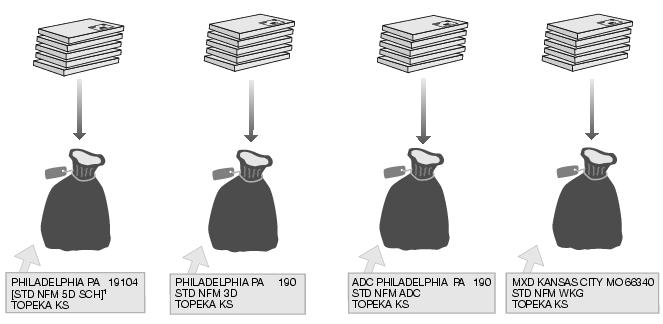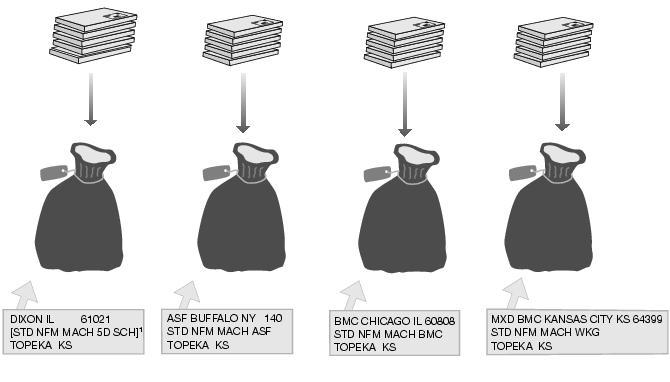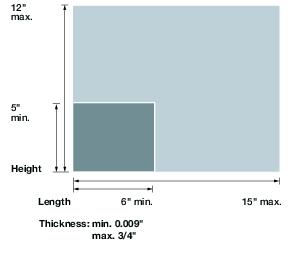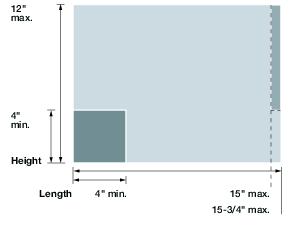|
Quick Service Guide 440d
Discount Parcels
Standard Mail Not Flat-Machinable Pieces
July 2007
Printer-Friendly PDF
Related QSG

703, Standard Mail Nonprofit Eligibility
Physical Standards (401)

Maximum weight: less than 16 ounces.
For an overview of the physical standards for Not Flat-Machinables (NFM), see Quick Service Guide 401.
Rates and Fees (443.1.0)

|
For pieces weighing 3.3 ounces (0.2063 pound) or less:
|
Regular
|
Nonprofit
|
|
|
$0.460
|
$0.334
|
|
|
0.506
|
0.380
|
|
|
0.767
|
0.641
|
|
|
1.028
|
0.902
|
|
|
|
|
|
|
$0.310
|
$0.208
|
|
|
0.356
|
0.254
|
|
|
0.617
|
0.515
|
|
|
0.878
|
0.776
|
|
|
0.739
|
0.622
|
Unless prepared in 5-digit/scheme containers, Not Flat-Machinable pieces are subject to a $0.05 surcharge if:
- Pieces weighing 6 ounces or more do not bear a UCC/EAN Code 128 barcode.
- Pieces weighing less than 6 ounces do not bear a UCC/EAN Code 128 or POSTNET barcode.
Destination discounts apply to mail prepared as prescribed by USPS and addressed for delivery within service area of destination BMC/ASF or SCF (346.2.0).
Annual $175.00 presort mailing fee.

Not Flat-Machinable pieces containing mailable items not required to be sent using First-Class Mail can be sent using Standard Mail. Standard Mail is typically used for advertisements, flyers, and catalogs. Additional content restrictions must be met for authorized nonprofit mailers (703.1.0).
Eligibility Standards (443)

Mailings of 200 or more addressed pieces (or 50 pounds of addressed pieces), sorted and marked as described below. All pieces must meet the physical standards for NFMs in (401). Pieces are eligible if not required to be mailed at First-Class Mail rates or not eligible for Periodicals rates. Nonprofit rates require specific authorization (703.1.0).
Each piece must include a complete delivery address with correct ZIP Code or ZIP+4 code.
A certified process must be used at least once a year to ensure accuracy of 5-digit ZIP Codes.
Each piece must bear a correct readable barcode under 708.4.0 or 708.5.0 as applicable, except if prepared in
5-digit/scheme containers or on 5-digit pallets. Pieces under 6 ounces may have a POSTNET (708.4.0) or
UCC/EAN Code 128 barcode (708.5.0), pieces 6 ounces or more must have a UCC/EAN Code 128 barcode. For barcode placement, see 402.4.0.
Postage Payment and Documentation (444)

Precanceled stamp (604.3.0), meter (604.4.0), or permit imprint (604.5.0).
Additional standards apply to mailings of nonidentical-weight pieces.
Documentation:
- Postage statement:
- Regular: Form 3602-R, Form 3602-EZ, or approved facsimile.
- Nonprofit: Form 3602-N, Form 3602-NZ, or approved facsimile.
- Supporting documentation: required unless correct rate is affixed to each piece or unless each piece is of identical weight and separated by rate when presented for acceptance; documentation generated by PAVE-certified software (or printed in standardized format).
Mail Preparation (445)

Mark each piece "Not Flat-Machinable" or "NFM" in the postage area (402.2.0) or in the optional endorsement line. Additional markings required:
- Regular: "Presorted Standard" or "PRSRT STD."
- Nonprofit: "Nonprofit Organization" or "NONPROFIT ORG." or "NONPROFIT."
See page two for preparation and labeling. For pallet preparation, see 705.8.0.
Prepared in sacks (unless palletized). Palletization is preferred, see Quick Service Guide 705d.
Enter and Deposit (446)

Mailing entered at an acceptance point designated by USPS.
For the specific DMM standards applicable to this category of mail, consult the DMM sections referenced above and the general sections within each DMM module.
Sacking Sequence for Pieces Less Than 6 Ounces ( 445.6.3.2)
|
|
|
|
5-Digit/Scheme
Sacks: Optional but required for 5-digit rate. 10 or more pounds to the same 5-digit ZIP Code; smaller volume not permitted except no minimum required when pieces are drop shipped to a DDU.
Labels: Line 1: For 5-digit scheme sacks, use L606, Column B. For 5-digit sacks, use city, state, and 5-digit ZIP Code on mail. Line 2: For 5-digit scheme sacks, use "STD NFM 5D SCH." For 5-digit sacks, use "STD NFM 5D."
Rate: Not Flat-Machinable 5-Digit
|
3-Digit
Sacks: Required when 10 or more pounds to the same 3-digit ZIP Code prefix; smaller volume not permitted.
Optional: One less-than-full sack may be prepared for any remaining pieces for each origin 3-digit ZIP Code.
Labels: For Line 1, use L002, Column A, for destination facility. For Line 2, use "STD NFM 3D."
Rate: Not Flat-Machinable 3-Digit or ADC
|
ADC
Sacks: Required when there are 10 or more pounds to the same ADC; smaller volume not permitted.
Labels: For Line 1, use L004, Column B for destination facility. For Line 2, use "STD NFM ADC."
Rate: Not Flat-Machinable ADC
|
Mixed ADC
Sacks: Any remaining pieces must be placed in mixed ADC sacks.
Labels: For Line 1, use L009, Column B. For Line 2, use "STD NFM WKG."
Rate: Not Flat-Machinable Mixed ADC
|
Mailers may make 5-digit bundles of at least five pieces when placed on pallets or in pallet boxes under 705.8.0. No other NFM bundles permitted.
|
For 5-digit scheme sacks, use "STD NFM 5D SCH." For 5-digit sacks, use "STD NFM 5D."
ADC rate for optional 3-digit origin/entry sack.
|
Sacking Sequence for Pieces 6 Ounces or More ( 445.6.3.3)
|
|
|
|
5-Digit/Scheme
Sacks: Optional, but required for 5-digit rate. Minimum 10 pounds, smaller volumes not permitted except no minimum required when pieces are drop shipped to a DDU.
Labels: Line 1: For 5-digit scheme sacks, use L606, Column B. For 5-digit sacks, use city, state, and 5-digit ZIP Code on mail. Line 2: For 5-digit scheme sacks, use "STD NFM MACH 5D SCH." For 5-digit sacks, use "STD NFM MACH 5D."
Rate: Not Flat-Machinable
5-Digit
|
ASF
Sacks: Optional, minimum 10 pounds, smaller volumes not permitted. Permitted only for mail deposited at an ASF to claim DBMC rates.
Labels: For Line 1, use L602, Column B. For Line 2, use "STD NFM MACH ASF."
Rate: Not Flat-Machinable ADC
|
BMC
Sacks: Required, minimum 10 pounds, smaller volumes not permitted.
Labels: For Line 1, use L601, Column B. For Line 2, use "STD NFM MACH BMC."
Rate: Not Flat-Machinable ADC
|
Mixed BMC
Sacks: Required, no minimum.
Labels: For Line 1, "MXD" followed by L601, Column B information for BMC serving the 3-digit ZIP Code prefix of the entry post office. For Line 2, use "STD NFM MACH WKG."
Rate: Not Flat-Machinable Mixed ADC
|
Mailers may make 5-digit bundles of at least five pieces when placed on pallets or in pallet boxes under 705.8.0. No other NFM bundles permitted.
|
For 5-digit scheme sacks, use "STD NFM MACH 5D SCH." For 5-digit sacks, use "STD NFM MACH 5D."
|
|
Not Flat-Machinable Decision Tree
|
|
Standard Mail mailpieces that are too thick or too rigid to run on automated flat sorting machines do not qualify for automation rates. These pieces are now categorized as "Not Flat-Machinable." This new category has higher prices than flats but lower prices than other parcels. This decision tree will help you determine if your piece qualifies as an automation flat or a Not Flat-Machinable.
|
|
1. Does your mailpiece:
a) Meet the minimum and maximum dimensions for an automation flat (see graphic on right), and
b) Have a rectangular shape, and
c) Meet the flexibility criteria in 301.1.3, and
d) Meet the uniform thickness criteria in 301.1.4, and
e) Meet the deflection (droop) criteria in 301.3.2.3 for flimsy pieces?
If yes, it meets the physical standards for an automation flat.
If no, go to number two.
2. Does your mailpiece:
a) Exceed one or more of the maximum dimensions for a letter and not measure more than 12 inches high or 15 inches long, or more than 3/4 inch thick, and
b) Meet criteria b, c, and d above?
If yes, it meets the physical standards for a nonautomation flat.
If no, go to number three.
|
|
|
3. Is your mailpiece rigid with the following dimensions?
a) At least 4 inches high, but not more than 12 inches high.
b) At least 4 inches long, but not more than 15-3/4 inches long.
c) At least 0.009 inch thick, but not more than 1-1/4 inches thick. (Pieces less than 5 inches long must be over 1/4 inch thick.)
If yes, it meets the physical standards for a Not Flat-Machinable piece.
If no, go to number four.
|
|
|
4. Is your mailpiece flexible with the following dimensions?
a) At least 4 inches high, but not more than 12 inches high, with either of the following dimensions:
b) Over 15 inches long, but not more than 15-3/4 inches long.
c) Over 3/4 inches thick, but not more than 1-1/4 inches thick.
If yes, it meets the physical standards for a Not Flat-Machinable piece.
|
|
|
Standard Mail flats and Not-Flat Machinable pieces must weigh less than 16 ounces.
Nonmachinable letter-size pieces weighing more than 3.3 ounces, unless they qualify to be mailed at automation flat-size rates, also qualify as Not Flat-Machinable pieces.
|
Back to Top
|














